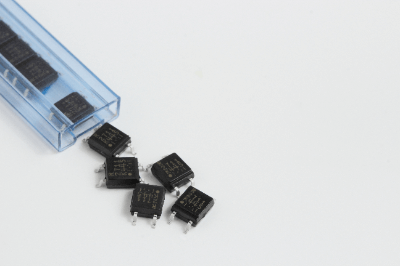What Is a Photocoupler?

A photocoupler is a device that can transmit a signal from an input side to an output side while electrically isolating the circuits on the input side and the output side.
It is also called an opto-isolator or optical isolator. In a photocoupler, the input electrical signal is converted to an optical signal using a light emitter, and the optical signal is converted back to an electrical signal using a light receiving element to make an output signal.
This means that signals can be transmitted even when the circuit on the output side is not electrically connected to the circuit on the input side. This high level of insulation is the primary reason for using photocouplers. Another feature is its relatively long life as a means of signal transmission.
Uses of Photocouplers
Photocouplers are used in devices that require high reliability due to their features of insulation and long life. Examples include medical electronic equipment.
In audio and communication equipment, where low noise is required, photocouplers are used to transmit signals from digital circuits to analog circuits, preventing noise from entering the analog circuits.
Photocouplers are also used in devices that drive motors. Recently, inverter-controlled motors are widely used, but noise generation is inevitable in rotation speed control. Since this noise can get into the equipment and cause malfunctions, signals are transmitted through photocouplers to block the noise from the motors.
In addition, photocouplers are also used to transmit signals between devices that operate on independent power supplies. Especially when connected to floating devices, there is a risk of electric shock, but if connected via photocouplers, safety can be ensured because the devices are insulated from floating devices.
Principle of Photocouplers
As mentioned above, a photocoupler is a unit that combines a light emitting element such as a light emitting diode and a light receiving element such as a phototransistor, and encloses these elements in a package that blocks light from the outside. The light emitting and light receiving elements are mounted close together. When the light emitting element is turned on, the light receiving element changes from the OFF state to the ON state, which is the principle of signal transmission by photocouplers.
The device outputting the signal connects to the input terminal of the photocoupler and turns the light emitting element on and off. The device receiving the signal is connected to the photocoupler’s output terminal via a pull-up resistor of a few kΩ to the power supply. With this configuration, the output terminal of the photocoupler is equal to the power supply voltage when the light-emitting element is off, and is about 0.1 V~0.3 while the light-emitting element is on.
That is, pulses appear in response to the turning on/off of the light-emitting element by the device outputting the signal, and the device on the receiving side receives these pulses and proceeds with signal processing. In this way, the photocoupler couples the input and output circuits via light, but there is no electrical connection between them because they are insulated.
Types of Photocouplers
There are various types of photocouplers, depending on the application. Typical elements are listed below.
1. Transistor Output Photocoupler
This is the basic configuration of photocouplers. It is still the most widely used photocoupler in the market due to its low price and high versatility. There are products with various features such as high conversion efficiency, high withstand voltage, and low input drive. They have a wide range of functions, and their main applications are signal isolation, feedback detection, and isolated switches.
2. IC Output Photocouplers
Photocouplers are integrated circuits with a light-receiving element to achieve high speed and specific functions. IC-output photocouplers can be further classified into the following three categories:
- Product groups designed for high-speed transmission of logic signals.
- Products with a driver function for external power devices.
- Products with current/voltage feedback function.
3. Triac Output Photocouplers
Used as isolated switches to directly control AC loads such as motors and solenoids directly connected to 100 V or 200 V commercial power supplies used in homes, offices, factories, and other locations. Using a triac with high element breakdown voltage, it is possible to control AC loads ON/OFF with a minute current of about 10 or more mA while electrically insulating them.
The element by itself can control only about 100mA of AC current, but by using it as a driver for an external triac, it can control AC currents up to several A.
4. MOSFET Output Photocoupler
The MOSFET output photocoupler has two MOSFETs connected at the source common in the output stage and has the same functionality as a mechanical relay. This is a feature of photocouplers.
Other Information on Photocouplers
Output Fluctuation and Life of Photocouplers
The current transfer ratio (CRT) is a characteristic parameter of photocouplers. The current transfer factor is the ratio of the output current (IC) to the input forward current (IF) and is equivalent to the DC current amplification factor (hFE) of a transistor.
- Value varies with IF
- Influenced by ambient temperature
- Gradually decreases over time
These factors must be taken into account when designing circuits. In other words, if the current transfer coefficient fluctuates due to environmental changes or over time, the output current will change, which may cause the circuit to malfunction. Therefore, it is important to examine the IF value, pull-up resistor resistance value, etc. to ensure that fluctuations in signal level do not affect the output current.
In addition, if a photocoupler is used for a long period of time, the current transfer coefficient will gradually decrease, and sufficient signal output will no longer be obtained. The main cause of the decrease in the current transfer coefficient is the deterioration of the LEDs, which results in a decrease in luminous efficiency.
The life expectancy of photocouplers is clearly stated in the device manufacturer’s literature, so it is necessary to determine the model and conditions of use with reference to this information.